悉尼歌剧院英文介绍
考拉和悉尼歌剧院的英文介绍
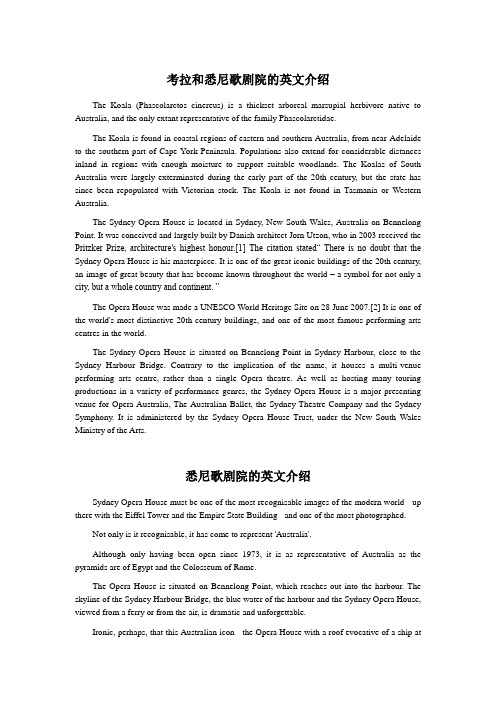
考拉和悉尼歌剧院的英文介绍The Koala (Phascolarctos cinereus) is a thickset arboreal marsupial herbivore native to Australia, and the only extant representative of the family Phascolarctidae.The Koala is found in coastal regions of eastern and southern Australia, from near Adelaide to the southern part of Cape York Peninsula. Populations also extend for considerable distances inland in regions with enough moisture to support suitable woodlands. The Koalas of South Australia were largely exterminated during the early part of the 20th century, but the state has since been repopulated with Victorian stock. The Koala is not found in Tasmania or Western Australia.The Sydney Opera House is located in Sydney, New South Wales, Australia on Bennelong Point. It was conceived and largely built by Danish architect Jørn Utzon, who in 2003 received the Pritzker Prize, architecture's highest honour.[1] The citation stated“ There is no doubt that the Sydney Opera House is his masterpiece. It is one of the great iconic buildings of the 20th century, an image of great beauty that has become known throughout the world – a symbol for not only a city, but a whole country and continent. ”The Opera House was made a UNESCO World Heritage Site on 28 June 2007.[2] It is one of the world's most distinctive 20th century buildings, and one of the most famous performing arts centres in the world.The Sydney Opera House is situated on Bennelong Point in Sydney Harbour, close to the Sydney Harbour Bridge. Contrary to the implication of the name, it houses a multi-venue performing arts centre, rather than a single Opera theatre. As well as hosting many touring productions in a variety of performance genres, the Sydney Opera House is a major presenting venue for Opera Australia, The Australian Ballet, the Sydney Theatre Company and the Sydney Symphony. It is administered by the Sydney Opera House Trust, under the New South Wales Ministry of the Arts.悉尼歌剧院的英文介绍Sydney Opera House must be one of the most recognisable images of the modern world - up there with the Eiffel Tower and the Empire State Building - and one of the most photographed.Not only is it recognisable, it has come to represent 'Australia'.Although only having been open since 1973, it is as representative of Australia as the pyramids are of Egypt and the Colosseum of Rome.The Opera House is situated on Bennelong Point, which reaches out into the harbour. The skyline of the Sydney Harbour Bridge, the blue water of the harbour and the Sydney Opera House, viewed from a ferry or from the air, is dramatic and unforgettable.Ironic, perhaps, that this Australian icon - the Opera House with a roof evocative of a ship atfull sail - was designed by renowned Danish architect - Jørn Utzon.In the late 1950s the NSW Government established an appeal fund to finance the construction of the Sydney Opera House, and conducted a competition for its design.Utzon's design was chosen. The irony was that his design was, arguably, beyond the capabilities of engineering of the time. Utzon spent a couple of years reworking the design and it was 1961 before he had solved the problem of how to build the distinguishing feature - the 'sails' of the roof.Sydney Opera House from the harbour, photo courtesy of Andrew WattsThe venture experienced cost blow-outs and there were occasions when the NSW Government was tempted to call a halt. In 1966 the situation - with arguments about cost and the interior design, and the Government withholding progress payments - reached crisis point and Jørn Utzon resigned from the project. The building was eventually completed by others in 1973.Sydney Opera House facts and figuresThe Sydney Opera house:Was designed by Danish architect Jørn Utzon.Was opened by Queen Elizabeth II on 20 October 1973.Presented, as its first performance, The Australian Opera's production of War and Peace by Prokofiev.Cost $AU 102,000,000 to build.Conducts 3000 events each year.Provides guided tours to 200,000 people each year.Has an annual audience of 2 million for its performances.Includes 1000 rooms.Is 185 metres long and 120 metres wide.Has 2194 pre-cast concrete sections as its roof.Has roof sections weighing up to 15 tons.Has roof sections held together by 350 kms of tensioned steel cable.Has over 1 million tiles on the roof.Uses 6225 square metres of glass and 645 kilometres of electric cable.SYDNEY, Australia-- Around every bend in Australia, there are natural beauties and magnificent vistas. But perhaps nothing identifies the country more than a breathtaking view of the Sydney Opera House.The Opera House, designed by Danish architect Jørn Utzon, is lauded by many as one of the architectural wonders of the modern world. It attracts 90 percent of tourists who visit Sydney and acts as a major home to the performing arts in Australia.Australian cuisineThe site of the opera house is some 500 yards from where the first European colonists landed in 1788. Fort Macquarie was established there at Bennelong Point in 1821. A tram depot came along in 1902. Trams were phased out in the 1950s, not long after Sydney Symphony Orchestra conductor Eugene Goossens began actively floating the idea of a concert hall. A government official seized on the concept and established an advisory committee, which selected the site of the old tram shed as the new home of the Sydney Opera House.In 1956, the government announced an international design competition. Utzon won the next year with his distinctive "soaring sails" vision of a harborside center. He said his idea for the structure had come from a simple source: the orange."All the shells are cut out of the same sphere," says Michael Lynch, chief executive of the Opera House Trust, "and now all have a common denominator."In an interesting aside, renowned American architect Frank Lloyd Wright didn't approve of the blueprints. "The circus tent is not architecture," Wright said.Reconciling with the architectConstruction of the Opera House took almost a decade and a half, and cost US $66 million, more than 14 times original projectionsConstruction began in 1959. It was supposed to take four years and cost $7 million Australian (US $4.7 million) -- to be paid from lottery revenues. That turned out to be an unrealistic figure."They went through extraordinary difficulty in trying to make the building work," Lynch says. "The sails themselves are all made out of pre-stressed concrete at a point where that was pretty much cutting-edge technology."Construction wasn't finished until 14 years later in 1973, with a $100 million Australian (US $66 million) price tag. Utzon didn't stick around for the completion. He left in 1966, disgusted with changes the New South Wales government wanted to make to his design -- as early as the first year of construction, for example, officials had demanded he double the number of performance spaces in the facility.Utzon vowed never to return. "I don't care if they pull the opera house down," he's reported to have said.The architect, now 81, apparently has had some change of heart over the years. The Sydney Morning Herald reports that he's agreed to help Australian architects upgrade the building. Thearticle says they'll travel to the Spanish island of Majorca to consult with Utzon on redesigning the interior to match the exterior. Utzon is not expected to come to Sydney for the project.Going for more than just concertsThe ceiling of the Opera House. The architect said the design concept came from an orange: 'Shells ... cut out of the same sphere'The complex boasts several performance halls that carry every genre of entertainment, from jazz to ballet. An estimated 3,000 performances each year are seen by about two million people."I think it's one of the great performance arts centers in the world," Lynch says. "The performing arts in Australia have blossomed, I think, largely because of the role that this building plays."Visitors are drawn to more than the performances. The complex holds cafes and shops, too. Today, more than 300,000 visitors tour the opera house each year.And with the eyes of the world turning to Australia for the year 2000 and its Summer Olympic Games there, it's a safe bet that the Sydney Opera House will remain the nation's true center stage.悉尼的英文简介Australia's premier city is the oldest settlement in Australia, the economic powerhouse of the nation and the country's capital, Canberra is everything but name. Built on the shores of the stunning Port Jackson, you would have to die and go to heaven before you see a more spectacular setting for a city. It's a vital, self-regarding metropolis, making itself a melting pot with people from all over the world.When to GoThe best times to visit are of spring and autumn, especially around March to April or October to November. Sydney is blessed with a temperate climate. Sometimes torrential downpours often break the heat between October and March. Winters are cool rather than cold. Beach lovers unperturbed by the hazards of lizard-skin should come between December and February.Sydney HarborThe harbor is the defining characteristic of the city. Its multiple sandstone headlands, dramatic cliffs, rocky islands and stunning bays and beaches, make it one of the most beautiful stretches of water in the world. Officially called Port Jackson, the harbor stretches some 20km inland to join the mouth of the Parramatta River. The most scenic area is on the ocean side of the bridge. The Sydney Harbor National Park protects the scattered pockets of bushland around the harbour and offers good walking tracks. The best way to experience the harbour is to go sailing, but if you're lacking nautical skills there are plenty of ways to enjoy it. Try catching the Manly ferry, swimming at Nielsen Park, walking from Manly to Spit Bridge, having a drink at Watsons Bay, dining with a view at Rose Bay, Balmoral or Circular Quay, or cruising to the heads on the Bounty.Sydney Opera HouseAustralia's most recognizable icon is dramatically situated on the eastern headland of Circular Quay. Its famous sail- and shell-like roofs were inspired by palm fronds, according to architect Jorn Utzon, but may remind you of turtles engaging in sexual congress. The Opera House is so unique that it has been photographed a zillion times, appears on an army of cheap t-shirts, every other Sydney postcard and decorates the frames of Dame Edna's dramatic glasses. It was built between 1959 and 1973, but plagued with construction delays and political difficulties which culminated in the resignation of Utzon in 1966. Although some visitors are disappointed by the interior, designed by a consortium of Australians after Utzon quit, it's a truly memorable place to see a performance or to sit at one of its outdoor cafes with a bottle of white wine and watch harbour life go by. The Opera House hosts theatre, classical music, ballet and film, as well as the seasonal opera performances. There is free music on the prow of the Opera House on weekends and a craft market on the forecourt on Sunday.The RocksThe Rocks is the oldest, quaintest part of Sydney. Today it is unrecognizable from the squalid, overcrowded and plague-ridden place it used to be. Reinvented by visionaries in the building industry and the trade union movement in the 1970s, the Rocks is now a sanitized, historical tourist precinct, full of cobbled streets, colonial buildings and stuffed koalas. If you ignore the kitsch, a stroll around the Rocks can be delightful. Attractions include the weekend market, the Earth Exchange geological and mining museum, and numerous craft shops and art galleries.But it's the old buildings, alleyways and historic facades that attract most visitors. Try exploring the less developed areas in the contiguous suburb of Millers Point, which has not sacrificed its community life to the tourist dollar. Check out the Lord Nelson Brewery Hotel and The Hero of Waterloo, two of Sydney's oldest pubs.Circular QuayCircular Quay is built around Sydney Cove and is considered by many to be the focal point of the city. The first European settlement in Australia grew around the Tank Stream which now runs underground into the harbour here. For many years this was the shipping centre of Sydney, but it's now both a commuting hub and a recreational space, combining ferry quays, a railway station and the Overseas Passenger Terminal with harbour walkways, restaurants, buskers, parks, the Museum of Contemporary Art and, of course, the Sydney Opera House.Macquarie StreetSydney's greatest concentration of early public buildings grace Macquarie St, many of them commissioned by Governor Macquarie and designed by the convict architect Francis Greenway. The most impressive are the elegant, two-storied Parliament House, Sydney Hospital, the Mint Building, the exquisite Hyde Park Barracks, St James Church and the voluminous State Library. The Barracks and the Mint are now museums, the library hosts exhibitions and there are tours of both the hospital and Parliament House. Macquarie St is the eastern boundary of the Central Business District and borders the Domain and the Royal Botanic Gardens. It runs from Hyde Park to Circular Quay.The Domain, Art Gallery & Botanic GardensThe Domain is a large grassy area east of Macquarie St which was set aside by Governor Phillip for public recreation. Today it is used by city workers for lunchtime sports and as a place to escape the bustle of the city. On Sunday afternoons, it's the gathering place for impassioned soapbox speakers, who do their best to entertain or enrage their listeners. It is also the venue for free events held during the festival of Sydney in January and the popular Carols by Candlelight at Christmas. The Art Gallery of New South Wales is in the northeast corner of the Domain. It hasexcellent permanent exhibitions of Australian, European, Japanese and tribal art, and has some inspired temporary exhibits.The Royal Botanic Gardens encompass Farm Cove, the first bay east of Circular Quay, and include the site of the colony's first vegetable patch. They contain a magnificent collection of South Pacific plant life, tropical displays in the Arc and Pyramid glasshouses, and a beautiful, old-fashioned formal rose garden. The spectacularly located gardens are a favoured spot for family picnics and wedding photographs.Darling HarbourThis huge waterfront tourist and leisure park comprises walkways, gardens, museums, an aquarium, convention centre, casino, eateries and shops. It was once a thriving dockland area, but it declined to the level of an urban eyesore before being reinvented as Darling Harbour in the 1980s by a combination of vision, planning, politicking, forbearance and huge amounts of cash. The emphasis is on casual fun and enjoyment of the kind appreciated by families with small children and coach tourists. The highlights are the Sydney Aquarium, the Australian National Maritime Museum, the water sculpture, the Chinese Garden, the massive IMAX cinema, and the nearby Powerhouse Museum, Sydney's most spectacular museum.Bondi BeachBondi Beach is the grand dame of Sydney's beaches with a magnificent sweep of sand and a never-ending series of majestic rollers crashing into the shallows. The suburb of Bondi Beach is an eclectic mix of ice cream parlours, designer cafes, greasy fish & chips joints, kosher shops and surf fashion stores. The seafront promenade and pavilion have been given a welcome facelift; car parking and fixing the offshore sewage outlets remain the only problems.Ku-Ring-Gai-Chase National Park[R-p6]Ku-Ring-Gai Chase National Park covers 150 sq km (60 sq mi) of sandstone bushland at the mouth of the Hawkesbury River, 24km (15mi) north of Sydney. The park has over 100km (60mi) of shoreline, plenty of forest and wildlife, a number of walking tracks and some magnificent Aboriginal rock art. Elevated parts of the park offer superb views across Pittwater towards the northernmost suburbs of Sydney.Royal National ParkThe Royal National Park, 35km (22mi) south of city, is the oldest gazetted national park in the world. The sea of low scrub which covered the sandstone plateau in the north of the park was devastated by the 1994 bushfires, but the forested river valleys and the beaches were unscathed. The park is dissected by the Hacking River and there are riverside picnic and boat hiring facilities at Audley. There's a spectacular 26km (16mi) coastal track stretching the length of the park, whichis accessible from Bundeena. It passes the lovely lagoon beach at Wattamolla, and the popular surfing spot at Garie Beach. The best views are from the southern boundary of the park overlooking Bulli from the edge of the Illawarra escarpment.Most visitors to Sydney arrive at Kingsford Smith airport. Airfares to Australia are expensive - it's a long way from anywhere and flights are often heavily booked. The most pleasant way to get around in Sydney is by ferry. A trip on the Manly Ferry is the best way to experience the harbor if you can't charm someone into taking you sailing. Major roads from Sydney go north to Newcastle, west to the Blue Mountains, south to Melbourne and Canberra and down the south coast to Wollongong.Anyway, you will certainly find this trip to Sydney Australia one of your most memorable experiences in your life. The trip will leave you sweet memories that you would like to share with your family and your friends.SydneySydney is an important commercial(商业的),industrial(工业的)and tourist centre on the southeast coast of Australia.It is Australia's largest city with a population of more than three million.The city has many famous sights.The harbour is one of the largest and most beautiful in the world and Sydney Harbour Bridge(悉尼港桥)—or“The Coathanger”as the people of Sydney call it—has been a great tourist attraction for many years.However,the most famous sight here nowadays is the Opera House(歌剧院).Some people think that it is one of the most beautiful modern buildings in the world.Sydney is a very modern city,but it also has many places of interest.In the areas called The Rocks and Paddington,for example,you can still see some of the first houses that were ever built here.For entertainment(娱乐),there is a lot to do here.The city has many different kinds of restaurants,theatres,cinemas and nightclubs.There is also a zoo and a Koala Bear Park.Some of the best beaches in Australia are here,too.Surfing(冲浪)is the most popular sport in Sydney.In fact,there are so many surfers in the city that you have to register surfboards here just like you have to register motorcars!问题补充:list the tourist attractions mentioned above( )give a title to the passage( )1.Sydney Harbour Bridge2.the Opera House3.The Rocks and Paddington4.a zoo and a Koala Bear Park5.different kinds of restaurants,theatres,cinemas and nightclubs.6.the best beachesTour in Sydney悉尼是一个重要的商业,工业,旅游的中心在澳大利亚的东南沿海。
历史作业-悉尼歌剧院

基本资料:
英文名称:Sydney Opera House
地理位置:澳大利亚悉尼市贝尼朗岬角
歌剧院规模:悉尼歌剧院整个建筑占地1.84公顷,长183米,宽118米,高67米,相当于20层楼的高度
设计师:约恩〃乌松(丹麦)
悉尼歌剧院不仅是悉尼艺术文化的殿堂,更是悉尼的灵魂,是公认的20世纪世界十大奇迹之一,是悉尼最容易被认出的建筑,每天来自世界各地的观光客络绎不绝前来参观拍照,清晨、黄昏或星空,不论徒步缓行或出海遨游,悉尼歌剧院随时为游客展现不同多样的迷人风采。
悉尼歌剧院设备完善,使用效果优良,是一座成功的音乐、戏剧演出建筑。
那些濒临水面的巨大的白色壳片群,象是海上的船帆,又如一簇簇盛开的花朵,在蓝天、碧海、绿树的衬映下,婀娜多姿,轻盈皎洁。
这座建筑已被视为世界经典载入历史。
2003年4月悉尼歌剧院设计大师约恩〃乌松先生获2003普利策建筑学奖。
普利策奖是对约恩〃乌松和他的杰作的最终承认。
遗憾:2008年11月29日,约恩〃乌松先生在丹麦去世,享年90岁。
然而令人遗憾的是,这位悉尼歌剧院的设计大师,在他生前直至去世都没能够亲眼看过他自己的杰作。
Useful Trivia About the Sydney Opera House悉尼歌剧院逸事
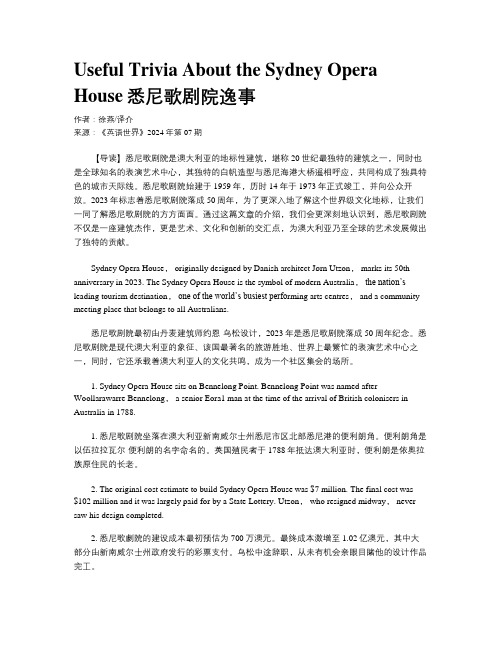
Useful Trivia About the Sydney Opera House悉尼歌剧院逸事作者:徐燕/译介来源:《英语世界》2024年第07期【导读】悉尼歌剧院是澳大利亚的地标性建筑,堪称20世纪最独特的建筑之一,同时也是全球知名的表演艺术中心,其独特的白帆造型与悉尼海港大桥遥相呼应,共同构成了独具特色的城市天际线。
悉尼歌剧院始建于1959年,历时14年于1973年正式竣工,并向公众开放。
2023年标志着悉尼歌剧院落成50周年,为了更深入地了解这个世界级文化地标,让我们一同了解悉尼歌剧院的方方面面。
通过这篇文章的介绍,我们会更深刻地认识到,悉尼歌剧院不仅是一座建筑杰作,更是艺术、文化和创新的交汇点,为澳大利亚乃至全球的艺术发展做出了独特的贡献。
Sydney Opera House, originally designed by Danish architect Jørn Utzon, marks its 50th anniversary in 2023. The Sydney Opera House is the symbol of modern Australia,the nation’s leading tourism destination,one of the world’s busiest perfo rming arts centres, and a community meeting place that belongs to all Australians.悉尼歌剧院最初由丹麦建筑师约恩·乌松设计,2023年是悉尼歌剧院落成50周年纪念。
悉尼歌剧院是现代澳大利亚的象征、该国最著名的旅游胜地、世界上最繁忙的表演艺术中心之一,同时,它还承载着澳大利亚人的文化共鸣,成为一个社区集会的场所。
1. Sydney Opera House sits on Bennelong Point. Bennelong Point was named after Woollarawarre Bennelong, a senior Eora1 man at the time of the arrival of British colonisers in Australia in 1788.1. 悉尼歌剧院坐落在澳大利亚新南威尔士州悉尼市区北部悉尼港的便利朗角。
介绍悉尼歌剧院英语作文简介
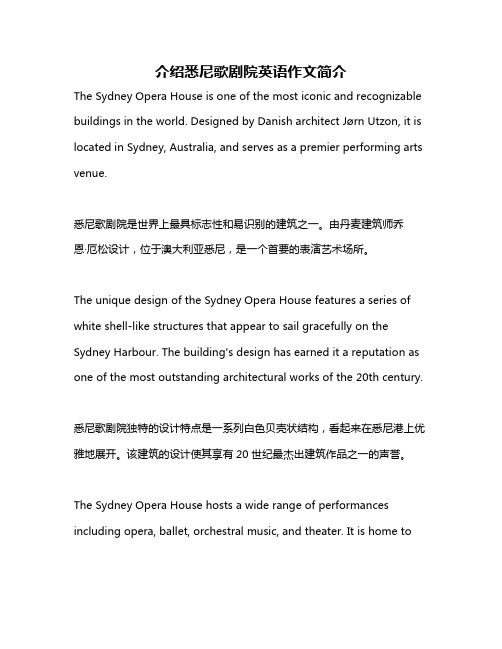
介绍悉尼歌剧院英语作文简介The Sydney Opera House is one of the most iconic and recognizable buildings in the world. Designed by Danish architect Jørn Utzon, it is located in Sydney, Australia, and serves as a premier performing arts venue.悉尼歌剧院是世界上最具标志性和易识别的建筑之一。
由丹麦建筑师乔恩·厄松设计,位于澳大利亚悉尼,是一个首要的表演艺术场所。
The unique design of the Sydney Opera House features a series of white shell-like structures that appear to sail gracefully on the Sydney Harbour. The building's design has earned it a reputation as one of the most outstanding architectural works of the 20th century.悉尼歌剧院独特的设计特点是一系列白色贝壳状结构,看起来在悉尼港上优雅地展开。
该建筑的设计使其享有20世纪最杰出建筑作品之一的声誉。
The Sydney Opera House hosts a wide range of performances including opera, ballet, orchestral music, and theater. It is home toseveral resident companies, including Opera Australia, the Sydney Theatre Company, and the Sydney Symphony Orchestra.悉尼歌剧院举办各种各样的表演,包括歌剧、芭蕾舞、管弦乐和戏剧。
悉尼歌剧院的外貌英文作文
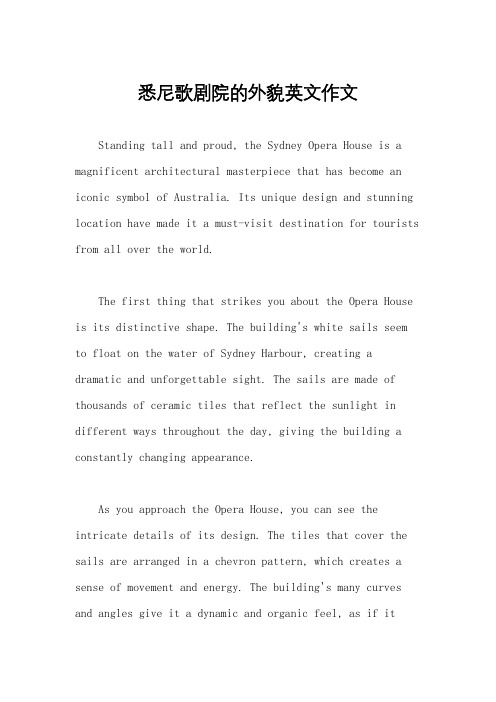
悉尼歌剧院的外貌英文作文Standing tall and proud, the Sydney Opera House is a magnificent architectural masterpiece that has become an iconic symbol of Australia. Its unique design and stunning location have made it a must-visit destination for tourists from all over the world.The first thing that strikes you about the Opera House is its distinctive shape. The building's white sails seem to float on the water of Sydney Harbour, creating a dramatic and unforgettable sight. The sails are made of thousands of ceramic tiles that reflect the sunlight in different ways throughout the day, giving the building a constantly changing appearance.As you approach the Opera House, you can see the intricate details of its design. The tiles that cover the sails are arranged in a chevron pattern, which creates a sense of movement and energy. The building's many curves and angles give it a dynamic and organic feel, as if itwere a living organism.Inside the Opera House, the design is just as impressive. The main concert hall is a vast space that can seat over 2,000 people. The walls and ceiling are coveredin a series of interlocking wooden panels that create a warm and intimate atmosphere. The acoustics of the hall are world-renowned, and it has hosted some of the greatest musicians and performers of our time.One of the most striking features of the Opera House is the way it interacts with its surroundings. The building is situated on a promontory that juts out into Sydney Harbour, and its location provides stunning views of the water and the city skyline. The building's many terraces and outdoor spaces allow visitors to enjoy the beauty of the harbour and the surrounding parkland.In conclusion, the Sydney Opera House is a true marvel of modern architecture. Its unique design, stunning location, and world-class facilities make it a must-see destination for anyone visiting Australia. Whether you're alover of music, art, or simply beautiful buildings, the Opera House is sure to leave a lasting impression on you.。
介绍悉尼歌剧院英语作文简介
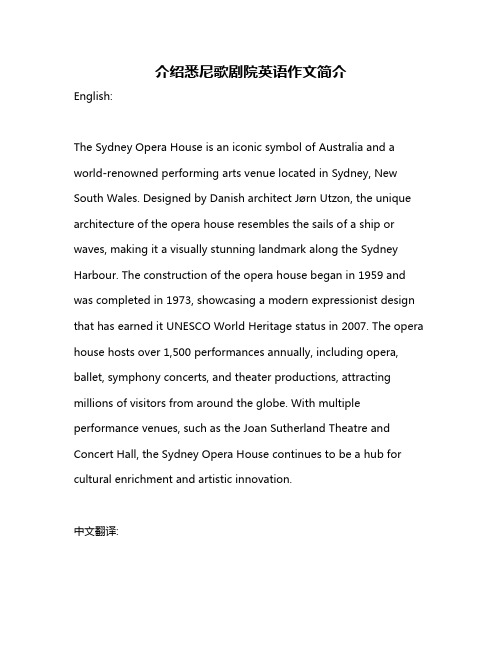
介绍悉尼歌剧院英语作文简介English:The Sydney Opera House is an iconic symbol of Australia and a world-renowned performing arts venue located in Sydney, New South Wales. Designed by Danish architect Jørn Utzon, the unique architecture of the opera house resembles the sails of a ship or waves, making it a visually stunning landmark along the Sydney Harbour. The construction of the opera house began in 1959 and was completed in 1973, showcasing a modern expressionist design that has earned it UNESCO World Heritage status in 2007. The opera house hosts over 1,500 performances annually, including opera, ballet, symphony concerts, and theater productions, attracting millions of visitors from around the globe. With multiple performance venues, such as the Joan Sutherland Theatre and Concert Hall, the Sydney Opera House continues to be a hub for cultural enrichment and artistic innovation.中文翻译:悉尼歌剧院是澳大利亚的标志性建筑,也是世界闻名的表演艺术场所,位于新南威尔士州的悉尼市。
英文我喜欢的建筑物作文

英文我喜欢的建筑物作文英文:I love the Sydney Opera House. It's a truly iconic building that has become a symbol of not only Sydney but also Australia as a whole. The design of the Opera House is so unique and striking, with its sail-like roofs and stunning waterfront location. Every time I see it, I can't help but feel a sense of awe and admiration for the architects who created such a masterpiece.One of the things I love most about the Sydney Opera House is its versatility. It's not just a place to see world-class performances, but it also hosts events, exhibitions, and tours. I remember going on a guided tour of the Opera House and learning about the history and design of the building. It was fascinating to see the behind-the-scenes areas and hear about the incredible acoustics of the concert halls.Another reason why I love the Sydney Opera House is because of the atmosphere it creates. There's something magical about attending a performance in such a grand and beautiful setting. I'll never forget the first time I saw a ballet performance there – the combination of the music, the dancers, and the stunning architecture was truly unforgettable.中文:我喜欢的建筑物是悉尼歌剧院。
介绍悉尼歌剧院英语作文

介绍悉尼歌剧院英语作文Sydney Opera House, an iconic landmark nestled on the beautiful Sydney Harbour, is not merely a architectural masterpiece, but also a symbol of Australia"s cultural heritage.With its sail-like roofs and shell-shaped design, this world-renowned performing arts venue has become an international symbol of creativity and innovation.悉尼歌剧院,这座坐落于美丽悉尼港的标志性建筑,不仅是一件建筑艺术的杰作,更是澳大利亚文化传承的象征。
其帆船式屋顶和贝壳状的设计,使这座世界闻名的表演艺术殿堂成为了创意与创新的国际标志。
Boasting a spectacular location with panoramic views of the Sydney Harbour Bridge and the city"s skyline, the Opera House stands as a testament to human ingenuity.It was designed by the Danish architect Jrn Utzon and opened in 1973, since then it has been hosting a diverse range of performances, including opera, ballet, drama, and concerts.悉尼歌剧院坐拥壮观的位置,可全景俯瞰悉尼海港大桥和城市天际线,它见证了人类的智慧与创造力。
悉尼歌剧院
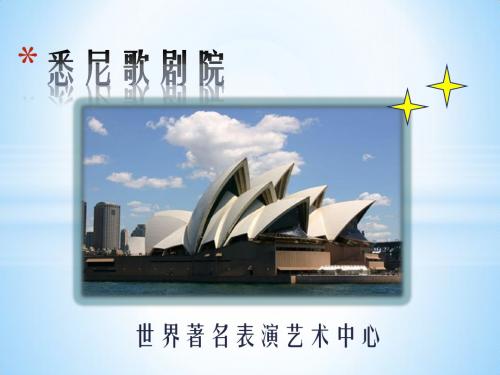
设 计 者 :
1956年,丹麦37岁的年轻建筑设计师约恩伍重看到了澳洲政府 向海外征集悉尼歌剧院的设计方案。虽然对远在天边的悉尼根本一 无所知,但是凭着从小生活在海滨渔村的生活积累所迸发的灵感, 他完成了这一设计方案,按他后来的解释,他的设计理念既非风帆, 也不是贝壳,而是切开的橘子瓣,但是他对前两个比喻也非常满意。 但是,当他寄出自己的设计方案的时候,他并没有料到,又一个 “安徒生童话”将要在异域的南半球上演。
*
世界著名表演艺术中心
*悉尼歌剧院简介: 悉尼歌剧院简介:
一、英文名称:Sydney Opera House 二、地理位置:澳大利亚悉尼市贝尼朗 岬角 三、歌剧院规模:悉尼歌剧院整个建筑 占地1.84公顷 四、设计师:约恩·伍重(Jorn Utzon) (丹麦)
外观
外观及内部结构: 外观及内部结构:
2003年4月,悉尼歌剧 院设计大师约恩伍重先生 获2003普利策建筑学奖。 普力策奖是对约恩伍重和 他的杰作的剧院设备完善,使 用效果优良,是一座成功的 音乐、戏剧演出建筑。那 些濒临水面的巨大的白色 壳片群,象是海上的船帆, 又如一簇簇盛开的花朵, 在蓝天、碧海、绿树的衬 映下,婀娜多姿,轻盈皎洁。
悉尼歌剧院不仅是悉尼艺 术文化的殿堂,更是悉尼的 灵魂,是公认的20世纪世界 十大奇迹之一,是悉尼最容 易被认出的建筑。
内部结构
*
建造历史: 建造历史:
建造悉尼歌剧院的计划始于1940年代,悉尼音乐学院的院长Eugene Goossens 游说建造一个能够表演大型戏剧作品的场所。Cahill于1955年9月13日发起了歌剧 院的设计竞赛,共收到了来自32个国家的233件参赛作品。参赛作品的规定是必须 有一个能容下3000人的大厅和一个能容下1200人的小厅,两个厅都要被设计成有不 同的用途,包括歌剧,交响乐和合唱音乐会,大规模的会议,讲座,芭蕾舞演出和 其他演讲。
悉尼歌剧院的英文介绍ppt

Sydney Opera House not only is it recognizable, it has come to represent “Australia” Sydney Opera House must be one of the most recognizable images of the modern world - up there with the Eiffel Tower and the Empire State Building - and one of the most photographed. There are 318001images from .
•Sydney Opera House (悉尼歌剧院 )
工程11-2
赵兴洪
The Opera House is situated on Bennelong Point, which reaches out into the harbor. The skyline of the Sydney Harbor Bridge, the blue water of the harbor and the Sydney Opera House, viewed from a ferry or from the air, is dramatic and unforgettable.
Sydney Opera House facts and figures
Was designed by Danish architect Jorn Utzon(约恩·乌 松). Was opened by Queen Elizabeth II on 20 October 1973. Presented, as its first performance, The Australian Opera's production of War and Peace by Prokofiev. Cost $AU 10.2million to build. Conducts 3000 events each year. Provides guided tours to 200,000 people each year.
介绍悉尼歌剧院的英语作文
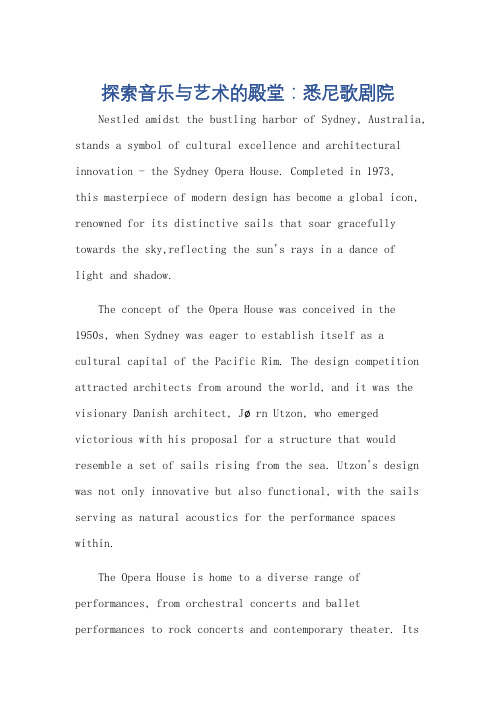
探索音乐与艺术的殿堂:悉尼歌剧院Nestled amidst the bustling harbor of Sydney, Australia, stands a symbol of cultural excellence and architectural innovation - the Sydney Opera House. Completed in 1973,this masterpiece of modern design has become a global icon, renowned for its distinctive sails that soar gracefully towards the sky,reflecting the sun's rays in a dance oflight and shadow.The concept of the Opera House was conceived in the1950s, when Sydney was eager to establish itself as a cultural capital of the Pacific Rim. The design competition attracted architects from around the world, and it was the visionary Danish architect, Jørn Utzon, who emerged victorious with his proposal for a structure that would resemble a set of sails rising from the sea. Utzon's design was not only innovative but also functional, with the sails serving as natural acoustics for the performance spaces within.The Opera House is home to a diverse range of performances, from orchestral concerts and ballet performances to rock concerts and contemporary theater. Itsstate-of-the-art acoustics and stage technology ensure that every performance is delivered with the utmost clarity and precision. The Opera House's main performance venue, the Concert Hall, seats 2,000 people and is renowned for its exceptional sound quality. Other venues include the Opera Theater, Drama Theater, and the Bennett Studio, which are all designed to cater to different types of performances. The exterior of the Opera House is as much a work ofart as the performances within. The white sails are made of precast concrete, a material that was chosen for its durability and ability to reflect light. The sails are supported by a steel framework that is both strong and lightweight, allowing for maximum openness and naturallight to flood the interior spaces.The Opera House is not just a performing arts center;it is also a hub for cultural exchange and education. It hosts workshops, masterclasses, and other educational programs that aim to enhance the understanding and appreciation of the performing arts among the general populace. The Opera House also collaborates with various cultural institutions and organizations to present adiverse range of programming that reflects the rich tapestry of Australian and international culture.The Sydney Opera House is not just a building; it is a symbol of Sydney's commitment to cultural excellence and artistic innovation. It stands as a testament to the power of architecture to transform a city's identity and to inspire people from all over the world. As the sun sets over the harbor, the Opera House glows in the twilight, a beacon of culture and creativity that will continue to inspire generations to come.**探索音乐与艺术的殿堂:悉尼歌剧院**在澳大利亚悉尼繁忙的港口中,坐落着一座文化和建筑创新的象征——悉尼歌剧院。
考拉和悉尼歌剧院的英文介绍
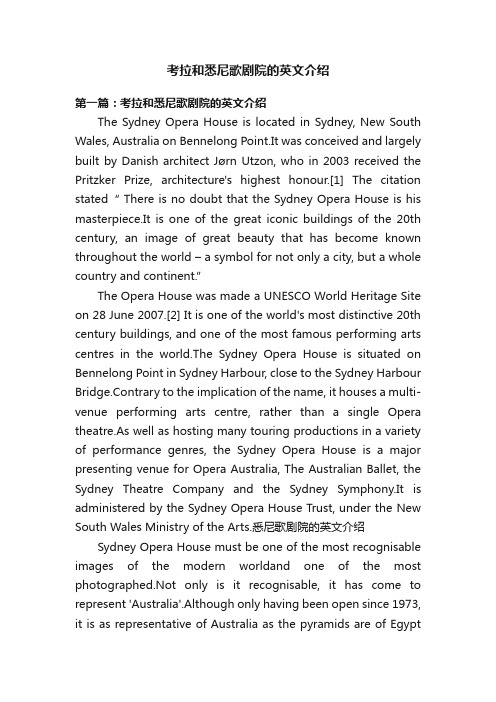
考拉和悉尼歌剧院的英文介绍第一篇:考拉和悉尼歌剧院的英文介绍The Sydney Opera House is located in Sydney, New South Wales, Australia on Bennelong Point.It was conceived and largely built by Danish architect Jørn Utzon, who in 2003 received the Pritzker Prize, architecture's highest honour.[1] The citation stated“ There is no doubt that the Sydney Opera House is his masterpiece.It is one of the great iconic buildings of the 20th century, an image of great beauty that has become known throughout the world – a symbol for not only a city, but a whole country and continent.”The Opera House was made a UNESCO World Heritage Site on 28 June 2007.[2] It is one of the world's most distinctive 20th century buildings, and one of the most famous performing arts centres in the world.The Sydney Opera House is situated on Bennelong Point in Sydney Harbour, close to the Sydney Harbour Bridge.Contrary to the implication of the name, it houses a multi-venue performing arts centre, rather than a single Opera theatre.As well as hosting many touring productions in a variety of performance genres, the Sydney Opera House is a major presenting venue for Opera Australia, The Australian Ballet, the Sydney Theatre Company and the Sydney Symphony.It is administered by the Sydney Opera House Trust, under the New South Wales Ministry of the Arts.悉尼歌剧院的英文介绍Sydney Opera House must be one of the most recognisable images of the modern worldand one of the most photographed.Not only is it recognisable, it has come to represent 'Australia'.Although only having been open since 1973, it is as representative of Australia as the pyramids are of Egyptand the Colosseum of Rome.The Opera House is situated on Bennelong Point, which reaches out into the harbour.The skyline of the Sydney Harbour Bridge, the blue water of the harbour and the Sydney Opera House, viewed from a ferry or from the air, is dramatic and unforgettable.Ironic, perhaps, that this Australian iconwas designed by renowned Danish architectthe 'sails' of the roof.Sydney Opera House from the harbour, photo courtesy of Andrew Watts。
悉尼歌剧院英文介绍
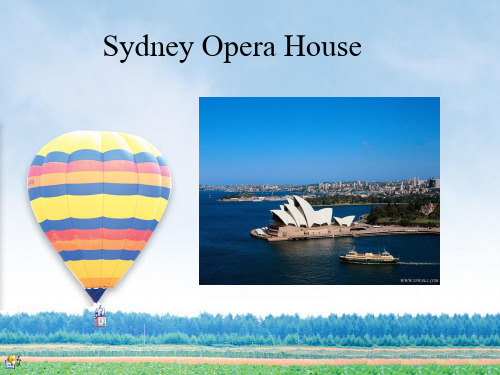
the history
In the late 1950s the Australian Government established an appeal fund to finance for the construction of the Sydney Opera House and a young Danish architect John Utzon wanted to take part in the competition. One day, during the breakfast time, he was thinking the project as peeling the orange. Suddenly, he found peeled orange liked geometric[dʒɪ'ɒmɪtrɪ] figure(几何 图形).Then he finished his project quickly and sent it. Sydney Opera House looks like an orange froma distance, isn't it?
The architect John Utzon
Sydney Opera House was opened by Queen Elizabeth on 20th October 1973Sydney Opera House.
The Location
The Opera House reaches out into the harbour.Seen from the air or the skyline of the Sydney Opera House, the blue water of the harbour and the Sydney Harbour Bridge is so beautifulSydney Opera House.
介绍悉尼歌剧院英语作文
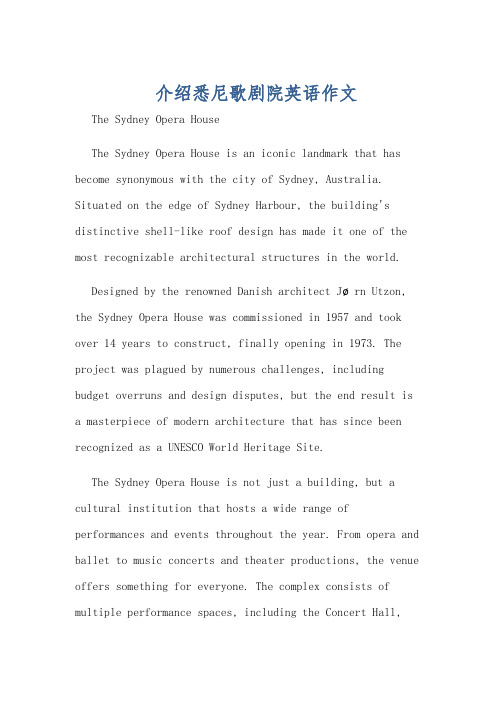
介绍悉尼歌剧院英语作文The Sydney Opera HouseThe Sydney Opera House is an iconic landmark that has become synonymous with the city of Sydney, Australia. Situated on the edge of Sydney Harbour, the building's distinctive shell-like roof design has made it one of the most recognizable architectural structures in the world.Designed by the renowned Danish architect Jørn Utzon, the Sydney Opera House was commissioned in 1957 and took over 14 years to construct, finally opening in 1973. The project was plagued by numerous challenges, including budget overruns and design disputes, but the end result is a masterpiece of modern architecture that has since been recognized as a UNESCO World Heritage Site.The Sydney Opera House is not just a building, but a cultural institution that hosts a wide range of performances and events throughout the year. From opera and ballet to music concerts and theater productions, the venue offers something for everyone. The complex consists of multiple performance spaces, including the Concert Hall,the Joan Sutherland Theatre, the Playhouse, and the Studio, each with its own unique acoustic properties and seating configurations.One of the most remarkable features of the Sydney Opera House is its innovative design. Utzon's vision was to create a building that would blend seamlessly with its natural surroundings, and he achieved this by using a series of interlocking concrete shells to form the distinctive roof structure. The shells are covered in over 1 million Swedish-designed ceramic tiles, which give the building its iconic white and cream color scheme.The interior of the Sydney Opera House is just as impressive as the exterior, with a range of materials and finishes that create a harmonious and visually stunning environment. The Concert Hall, for example, features a massive organ with over 10,000 pipes, and the Joan Sutherland Theatre is known for its exceptional acoustics, which allow for exceptional performances.Beyond its role as a cultural hub, the Sydney Opera House is also a significant tourist attraction, drawing millions of visitors each year who come to marvel at itsarchitectural beauty and experience the world-class performances on offer. The building's location on the edgeof Sydney Harbour only adds to its appeal, with stunning views of the city skyline and the iconic Sydney Harbour Bridge.In conclusion, the Sydney Opera House is a true masterpiece of modern architecture and a beloved cultural institution that has become an integral part of Sydney's identity. Its unique design, world-class performances, and stunning natural setting make it a must-visit destinationfor anyone traveling to Australia.悉尼歌剧院悉尼歌剧院是一座标志性的地标建筑,已成为悉尼城市的代名词。
悉尼歌剧院

负子鼠(Posum),后来有人将这些写成了一出歌剧,名字是:世界第八奇景(Eighth Wonder)。
5、 后台参观有如内参观的条件限制。
6、 每天的11:00和14:30(星期六的14:30除外),都会有普通话的导游服务。
悉尼歌剧院佚事
设计建造之曲折
悉尼歌剧院是从50年代开始构思兴建,1955年起公开搜集世界各地的设计作品,至1956年共有32个国家233个作品参选,后来丹麦建筑师约恩?乌松(又译为“杰恩-伍重”)的设计屏雀中选,约恩?乌松的设计灵感来自于橙子皮,该项目共耗时14年、斥资1200万澳币完成建造,为了筹措经费,除了募集基金外,澳洲政府还曾于1959年发行悉尼歌剧院彩券。
对悉尼歌剧院的评价
悉尼歌剧院不仅是悉尼艺术文化的殿堂,更是悉尼的灵魂,是公认的20世纪世界十大奇迹之一,是悉尼最容易被认出的建筑,每天来自世界各地的观光客络绎不绝前往参观拍照,清晨、黄昏或星空,不论徒步缓行或出海遨游,悉尼歌剧院随时为游客展现不同多样的迷人风采。
悉尼歌剧院设备完善,使用效果优良,是一座成功的音乐、戏剧演出建筑。那些濒临水面的巨大的白色壳片群,象是海上的船帆,又如一簇簇盛开的花朵,在蓝天、碧海、绿树的衬映下,婀娜多姿,轻盈皎洁。这座建筑已被视为世界的经典建筑载入史册。
悉尼歌剧院
悉尼歌剧院位於澳洲悉尼,是20世纪最具特色的建筑之一,也是世界著名的表演艺术中心,已成为悉尼市的标志性建筑。该歌剧院1973年正式落成,2007年6月28日被联合国教科文组织评为世界文化遗产,该剧院设计者为丹麦设计师约恩?乌松。悉尼歌剧院坐落在悉尼港的便利朗角(Bennelong Point),其特有的帆造型,加上悉尼港湾大桥,与周围景物相映成趣。
介绍悉尼歌剧院的画报作文英语
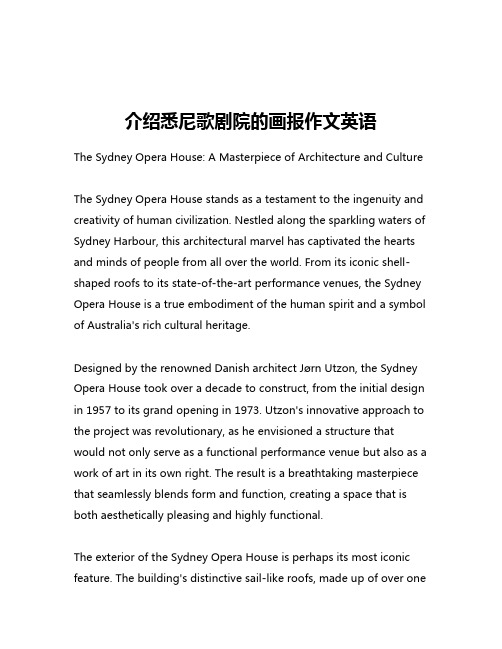
介绍悉尼歌剧院的画报作文英语The Sydney Opera House: A Masterpiece of Architecture and CultureThe Sydney Opera House stands as a testament to the ingenuity and creativity of human civilization. Nestled along the sparkling waters of Sydney Harbour, this architectural marvel has captivated the hearts and minds of people from all over the world. From its iconic shell-shaped roofs to its state-of-the-art performance venues, the Sydney Opera House is a true embodiment of the human spirit and a symbol of Australia's rich cultural heritage.Designed by the renowned Danish architect Jørn Utzon, the Sydney Opera House took over a decade to construct, from the initial design in 1957 to its grand opening in 1973. Utzon's innovative approach to the project was revolutionary, as he envisioned a structure that would not only serve as a functional performance venue but also as a work of art in its own right. The result is a breathtaking masterpiece that seamlessly blends form and function, creating a space that is both aesthetically pleasing and highly functional.The exterior of the Sydney Opera House is perhaps its most iconic feature. The building's distinctive sail-like roofs, made up of over onemillion individual tiles, have become an instantly recognizable symbol of Sydney and a source of immense pride for the city's residents. The roofs are not only aesthetically striking but also serve a practical purpose, as they help to regulate the building's temperature and protect the interior from the elements.The interior of the Sydney Opera House is equally impressive, with a range of performance venues that cater to a diverse array of artistic and cultural events. The largest of these venues is the Concert Hall, which can accommodate up to 2,679 people and is renowned for its exceptional acoustics. The Concert Hall is home to the Sydney Symphony Orchestra and has played host to some of the world's most renowned classical musicians and orchestras.In addition to the Concert Hall, the Sydney Opera House boasts several other performance venues, including the Opera Theatre, the Drama Theatre, and the Playhouse. Each of these spaces is designed with meticulous attention to detail, ensuring that the audience is treated to an unforgettable experience no matter the event. The interiors of these venues are adorned with stunning artwork, intricate architectural details, and state-of-the-art technology, creating a truly immersive and awe-inspiring experience for all who visit.Beyond its role as a performance venue, the Sydney Opera House is also a hub of cultural activity and community engagement. Thebuilding's extensive educational and outreach programs, which include workshops, tours, and public events, aim to inspire and educate people of all ages and backgrounds about the arts and the rich cultural heritage of Australia. The Sydney Opera House also serves as a gathering place for the local community, hosting a variety of events and activities that bring people together and foster a sense of unity and belonging.One of the most remarkable aspects of the Sydney Opera House is its ability to adapt and evolve over time. Despite its iconic status, the building is constantly undergoing renovations and upgrades to ensure that it remains at the forefront of the performing arts world. In recent years, the Opera House has undergone a major refurbishment project, which has included the installation of new lighting and sound systems, as well as the restoration of the building's historic interiors.The Sydney Opera House is not just a building – it is a living, breathing symbol of the human spirit and the power of the arts to inspire and transform. Whether you are a seasoned opera aficionado or a first-time visitor, the experience of stepping inside this architectural masterpiece is one that will stay with you forever. From the breathtaking views of Sydney Harbour to the world-class performances that grace its stages, the Sydney Opera House is a true jewel in the crown of Australia's cultural landscape.。
- 1、下载文档前请自行甄别文档内容的完整性,平台不提供额外的编辑、内容补充、找答案等附加服务。
- 2、"仅部分预览"的文档,不可在线预览部分如存在完整性等问题,可反馈申请退款(可完整预览的文档不适用该条件!)。
- 3、如文档侵犯您的权益,请联系客服反馈,我们会尽快为您处理(人工客服工作时间:9:00-18:30)。
The History
• Sydney Opera House was
•
designed by a famous architect,John Utzon. The appoint stated“ There is no doubt that the Sydney Opera House is his masterpiece. It is one of the great iconic buildings of the 20th century, an image of great beauty that has become known throughout the world a symbol for not only a city, but a whole country and continent. ”
John Utzon
The Structure
• 6 225 square meters of glass and
645 kilometers of electric cable were used to build the Opera House.It includes 1 000 rooms. The building’s roof sections weight about fifteen tons.There are 1 million tiles on the roof.It provides guided tours to many people each year.
Group 1Biblioteka 黄越 伍昱蓉 刘晓琴 王伊笑 邓彦泓 崔奕冉
The Status
• The Sydney Opera House is
one of the most famous buildings in the world. It is considered to be one of the most recognizable images of the modern world although the building has been open for only about 40 years.
It is one of the world's most distinctive 20th century buildings, and one of the most famous performing arts centres in the world.
